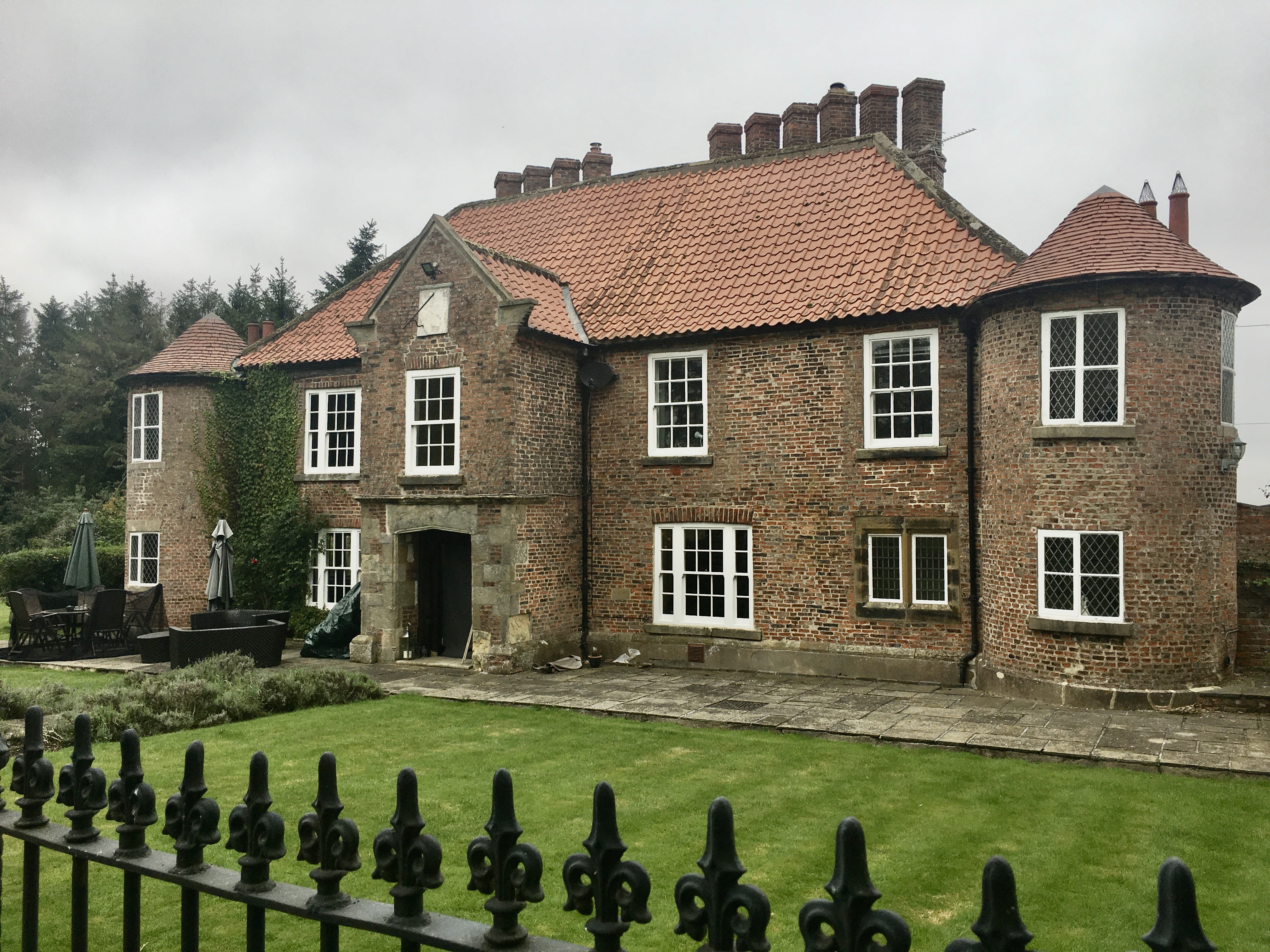Allerthorpe Hall, Allerthorpe
Full Address: Allerthorpe Hall, Allerthorpe , Allerthorpe , Yorkshire , England , Europe
Project: Yorkshire Mapping Project
Contributor: Joanna Barker

Caption: Allerthorpe hall [View image full screen]
- Letter from Elizabeth Montagu to Anne Donnellan (EMCO ID: 434)
- Letter from Elizabeth Montagu to Anne Donnellan (EMCO ID: 427)
- Letter from Elizabeth Montagu to Anne Donnellan (EMCO ID: 420)
- Letter from Elizabeth Montagu to Anne Donnellan (EMCO ID: 416)
- Letter from Elizabeth Montagu to Edward Montagu (EMCO ID: 409)
- Letter from Elizabeth Montagu to Edward Montagu (EMCO ID: 428)
- Letter from Elizabeth Montagu to Edward Montagu (EMCO ID: 400)
- Letter from Elizabeth Montagu to Edward Montagu (EMCO ID: 408)
- Letter from Elizabeth Montagu to Edward Montagu (EMCO ID: 440)
- Letter from Elizabeth Montagu to Edward Montagu (EMCO ID: 446)
- Letter from Elizabeth Montagu to Edward Montagu (EMCO ID: 433)
- Letter from Elizabeth Montagu to Edward Montagu (EMCO ID: 439)
- Letter from Elizabeth Montagu to Edward Montagu (EMCO ID: 445)
- Letter from Elizabeth Montagu to Edward Montagu (EMCO ID: 432)
- Letter from Elizabeth Montagu to Edward Montagu (EMCO ID: 438)
- Letter from Elizabeth Montagu to Edward Montagu (EMCO ID: 444)
- Letter from Elizabeth Montagu to Edward Montagu (EMCO ID: 431)
- Letter from Elizabeth Montagu to Edward Montagu (EMCO ID: 411)
- Letter from Elizabeth Montagu to Edward Montagu (EMCO ID: 443)
- Letter from Elizabeth Montagu to Edward Montagu (EMCO ID: 430)
- Letter from Elizabeth Montagu to Edward Montagu (EMCO ID: 417)
- Letter from Elizabeth Montagu to Edward Montagu (EMCO ID: 436)
- Letter from Elizabeth Montagu to Edward Montagu (EMCO ID: 423)
- Letter from Elizabeth Montagu to Edward Montagu (EMCO ID: 442)
- Letter from Elizabeth Montagu to Edward Montagu (EMCO ID: 429)
- Letter from Elizabeth Montagu to Elizabeth Drake Robinson (EMCO ID: 422)
- Letter from Elizabeth Montagu to George Lyttelton, 1st Baron Lyttelton of Frankley (EMCO ID: 1018)
- Letter from Elizabeth Montagu to Grace Robinson Freind (EMCO ID: 405)
- Letter from Elizabeth Montagu to Margaret Cavendish Bentinck, Duchess of Portland (EMCO ID: 441)
- Letter from Elizabeth Montagu to Margaret Cavendish Bentinck, Duchess of Portland (EMCO ID: 415)
- Letter from Elizabeth Montagu to Margaret Cavendish Bentinck, Duchess of Portland (EMCO ID: 447)
- Letter from Elizabeth Montagu to Margaret Cavendish Bentinck, Duchess of Portland (EMCO ID: 421)
- Letter from Elizabeth Montagu to Margaret Cavendish Bentinck, Duchess of Portland (EMCO ID: 414)
- Letter from Elizabeth Montagu to Margaret Cavendish Bentinck, Duchess of Portland (EMCO ID: 407)
- Letter from Elizabeth Montagu to Margaret Cavendish Bentinck, Duchess of Portland (EMCO ID: 413)
- Letter from Elizabeth Montagu to Margaret Cavendish Bentinck, Duchess of Portland (EMCO ID: 419)
- Letter from Elizabeth Montagu to Margaret Cavendish Bentinck, Duchess of Portland (EMCO ID: 406)
- Letter from Elizabeth Montagu to Margaret Cavendish Bentinck, Duchess of Portland (EMCO ID: 425)
- Letter from Elizabeth Montagu to Margaret Cavendish Bentinck, Duchess of Portland (EMCO ID: 412)
- Letter from Elizabeth Montagu to Margaret Cavendish Bentinck, Duchess of Portland (EMCO ID: 418)
- Letter from Elizabeth Montagu to Margaret Cavendish Bentinck, Duchess of Portland (EMCO ID: 437)
- Letter from Elizabeth Montagu to Margaret Cavendish Bentinck, Duchess of Portland (EMCO ID: 424)
- Letter from Elizabeth Montagu to Margaret Cavendish Bentinck, Duchess of Portland (EMCO ID: 404)
- Letter from Elizabeth Montagu to Margaret Cavendish Bentinck, Duchess of Portland (EMCO ID: 410)
- Letter from Elizabeth Montagu to Margaret Cavendish Bentinck, Duchess of Portland (EMCO ID: 403)
- Letter from Elizabeth Montagu to Margaret Cavendish Bentinck, Duchess of Portland (EMCO ID: 435)
- Letter from Elizabeth Montagu to Mary Robinson (EMCO ID: 2128)
- Letter from Elizabeth Montagu to Morris Robinson (EMCO ID: 3124)
- Letter from Elizabeth Montagu to William Freind (EMCO ID: 426)
Allerthorpe Hall is outside the small village of Gatenby, a few miles from Burneston in North Yorkshire, close to its border with County Durham. Immediately following her marriage in 1742, Elizabeth Montagu and her husband travelled to Allerthorpe Hall with her sister Sarah, and the two women stayed there until after Christmas.
In August 1744, Edward and Elizabeth Montagu, together with their young son John, known as ‘Punch’, travelled north to Allerthorpe, stopping at Stowe and at Newbold Verdon in Leicestershire, the home of her husband’s brother James Montagu, and passing through York. It was at Allerthorpe one month later that Punch died of convulsions attributed to teething at the age of 15 months; the child was buried at Burneston, and his remains transferred after his mother’s death in 1800 to her vault in Winchester Cathedral.
The Manor of Allerthorpe had previously belonged to a family named Robinson, but whether they were connected with Elizabeth Montagu’s father’s family has not been clearly established. The Lascelles family held the Manor from at least 1270, and in 1590 Sir Thomas Lascelles sold it to William Robinson (1534-1616), who was twice Lord Mayor of the City of York. It passed to his son Thomas Robinson, who built Allerthorpe Hall in 1608. On Thomas’s death in 1626 he left his estate to his brother William, with the exception of the manors of Allerthorpe and Swainby, which passed to his sister Frances Harrison on the basis of an entail: the property would remain in her family for eighty years and then revert to William’s heirs. In 1688 his grandson, another Thomas Harrison, was able to break the entail and retain the property.
In 1691 Charles Montagu married Sarah Rogers and settled into trust the sum of £11,000, of which £8,000 was his wife’s marriage portion, on condition that the money should be used to purchase a property in Yorkshire, Durham or Northumberland to secure a jointure to his widow if he predeceased her, and subsequent payments to any children born to them. In 1713 the trustees, who included his brother Sidney Wortley Montagu and cousin Sir James Montagu, purchased the estates of Allerthorpe, Burneston and Swainby from Thomas Harrison for this purpose. When Sarah died in 1745, her only surviving children were Edward Montagu and his sister Jemima (two other sons having died); Edward became owner of the estate and compensated his sister with a cash sum (Tyne & Wear Archive [TWA], Acc1583/box14/C/43a). For a while Edward Montagu adopted Allerthorpe Hall as his formal residence: Debrett’s Peerage of 1790 said that Elizabeth Robinson married ‘Edward Montagu esq. of Allerthorpe’, and his will made in 1752 began with the words ‘I, Edward Montagu, of Allerthorpe in the County of York’.
In 1742, on his marriage to Elizabeth Robinson, Edward undertook to transfer the Allerthorpe estates into trust to secure her widow’s jointure for the annual sum of £400 (TWA Acc1583/box 14/bundle/33a). The trust was set up in 1745 but the income from the estate flowed to Edward during his lifetime, and his wife regarded it as continuing to belong to him: in a letter to her cousin Grace Freind sent from Allerthorpe shortly after her marriage, she wrote, ‘Here we are situated in a fine country, and Mr Montagu has the pleasure calling many hundred pounds a year about his house his own, without any person’s property interfering with it: I think it is the prettiest estate, and in the best order I ever saw’ (Climenson, I, 122-23). In a later letter to her sister-in-law Mary Robinson, she described her visit to Burneston and Allerthorpe for the first time after her husband’s death, saying, ‘As Mr Montagu had been always a very good Landlord, I thought it right to show the good people they would have a kind Landlady’ (British Library ADD 40663, ff. 50-54). The Hall was, however, the scene of tragedy when Edward and Elizabeth’s son John (known as Punch) died there of convulsions at the age of fifteen months. The couple do not appear to have stayed there after 1747, and it was let to tenants.
(There has over the years been some confusion about the ownership of Allerthorpe. According to Historic England, Rev Matthew Robinson (1628-1694), Elizabeth Montagu’s great-great-uncle, was ‘Vicar of Burneston and owner of Allerthorpe Hall’; this is incorrect. The genealogist Samuel Egerton Brydges, who married Revd. William Robinson’s daughter Mary, wrote in his unfinished biography of Matthew Robinson Morris, 2nd Lord Rokeby, that he was born in York, ‘in which county (about Burneston and Allerthorpe) were his paternal estates; a property of which he did not come into possession till the death of his father in 1778’. There were indeed properties in Yorkshire that belonged to Matthew Robinson, but these did not include Burneston or Allerthorpe.)
On her husband’s death, the Allerthorpe estates became the property of Elizabeth Montagu, and when she arranged the marriage of her nephew Matthew to Elizabeth Charlton in 1785, she transferred them into trust to secure their marriage settlement. It subsequently passed successively to Matthew’s sons Edward and Henry, the 5th and 6th Barons Rokeby. Since there were no further male heirs, Henry divided his estates between his daughters, and Allerthorpe was left to Harriet Lydia Montagu, who married the 4th Earl of Portarlington. On her death in 1904 she left it to Mary Lydia, only daughter of her second son, Montagu Francis Beauchamp Seymour Dawson-Damer. Mary Lydia died in 1969 at the age of 71; her only son emigrated to Australia and predeceased her in 1940. None of these family members appears to have occupied the Hall at any time, so it was presumably let to tenants. Today Allerthorpe Hall is in private hands but is not occupied by the owner and is let out. Its outward appearance has barely changed, and reportedly the interior also retains many of its original features.
Please note that all dates and location information are provisional, initially taken from the library and archive catalogues. As our section editors continue to work through the material we will update our database and the changes will be reflected across the edition.
Browser support: The website works best using the Chrome, Edge, and Firefox browsers on the PC, and only Chrome and Firefox on the Mac.




